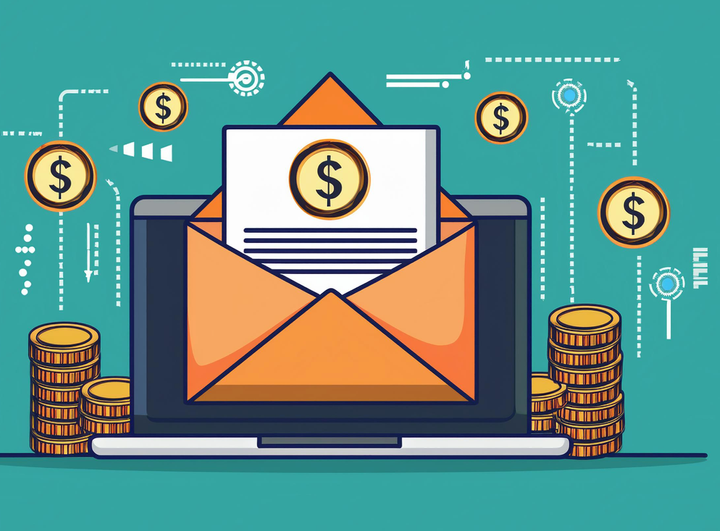The True Cost of Email Downtime for SaaS Companies
Customers aren't getting emails to confirm their purchases. Requests to reset passwords are not working. The worst part is that their automated billing system can't send out renewal notices.

It's Black Friday morning, and a well-known project management SaaS is having its biggest sale of the year. They realize something is wrong within a few hours.
Customers aren't getting emails to confirm their purchases. Requests to reset passwords are not working. The worst part is that their automated billing system can't send out renewal notices.
They lose $47,000 in direct revenue and receive more than 200 confused customer support tickets by the time they figure out what's wrong with the email delivery and fix it six hours later.
Sound dramatic? It happens more often than you'd think.
What Exactly Is Email Downtime?
Before we dive into the costs, let's get clear on what we're talking about.
Email downtime isn't just your email server going completely dark (though that's certainly part of it). It includes:
Complete outages:Nothing gets sent or delivered at all
Delivery delays: Emails eventually arrive, but hours or days late
Spam filtering problems: Your emails end up in junk folders instead of inboxes
Partial failures: Some email types work while others don't
Think of your email system like a highway system. Sometimes there's a complete roadblock (total outage), sometimes there's heavy traffic causing delays, and sometimes your messages take the wrong exit and end up in spam-ville instead of reaching their destination.
The problem? Most SaaS companies treat email like a simple utility—something that just works in the background. However, when it breaks, the damage permeates your business like foundational cracks, often in unexpected ways.
The Immediate Money Drain
Let's start with the obvious stuff—the revenue you lose right away when emails stop working.
When Critical Emails Go Missing
Your customers depend on certain emails to actually use your product. When a new user signs up and doesn't receive their welcome email with login instructions, they can't get started. When someone forgets their password and the reset email never arrives, they're locked out. When a customer makes a purchase but never gets their confirmation email, they panic and might dispute the charge.
Here are the emails that directly impact your bottom line:
- Purchase confirmations: Customers who don't receive these often assume something went wrong and request refunds
- Subscription renewal notices:Miss these, and customers might not realize their card will be charged, leading to disputes
- Password resets: Locked-out users can't access your service (and can't pay for it)
- Trial expiration warnings: Users need advance notice to decide whether to upgrade
The Shopping Cart Graveyard
E-commerce SaaS companies know that abandoned cart emails can recover 10-15% of lost sales. When these emails fail during a busy period, that's real money walking out the door. For a company processing $100,000 in monthly transactions, a day-long email outage could mean losing $1,500-2,500 in recovered sales.
Promotional Campaigns That Fall Flat
Time-sensitive promotions are particularly vulnerable. Launch a 24-hour flash sale, and if your announcement emails don't deliver, you've essentially thrown your marketing budget into a black hole. Even worse, if only some of your customers receive the emails, you might face complaints about "unfair" limited-time offers.
Putting Numbers to the Pain
Here's a simple way to calculate your immediate risk: Take your average daily revenue and multiply it by the percentage that depends on email functionality. For most SaaS companies, this ranges from 15-40%. A company making $10,000 daily with 25% email dependency could lose $2,500 per day during a complete email outage.
But that's just day one. The real damage compounds over time.
When Customer Experience Takes a Hit
Money lost is one thing, but damaged customer relationships are harder to repair and more expensive in the long run.
The Trust Problem
Your customers develop expectations about how your service works. New users expect to receive onboarding emails. Existing customers expect notifications about account changes. When these expectations aren't met, customers don't usually think "Oh, they must be having email problems." They think "This company doesn't have their act together."
This trust erosion is particularly dangerous for SaaS companies because your service relationship is ongoing. A retail customer might forgive a single bad experience, but SaaS customers evaluate your reliability every single month when they see that subscription charge.
Support Team Chaos
When emails stop working, your support team gets hit with a tsunami of tickets:
- "I never received my welcome email"
- "Where's my invoice?"
- "I tried to reset my password but nothing happened"
- "Did my payment go through?"
Each ticket costs money to handle (industry average is $15-25 per ticket), and your team has to spend time explaining problems instead of helping customers succeed with your product. During TechFlow's six-hour outage, they received 200 extra support tickets. At $20 per ticket, that's an additional $4,000 in support costs, not counting the opportunity cost of their team being distracted from higher-value activities.
Onboarding Disasters
New customer onboarding is crucial for SaaS success. Studies show that customers who don't complete onboarding within the first week are 70% more likely to churn. When welcome emails, tutorial sequences, and setup guides don't arrive, new customers are left confused and frustrated during their most vulnerable period.
Think of it like buying a new gadget and not receiving the instruction manual. Sure, you might figure it out eventually, but you're starting with a negative experience that colors everything that follows.
The Snowball Effect
Here's where it gets really expensive. When customers experience email problems, they start questioning everything about your service. If you can't reliably send emails, can you reliably protect their data? Process their payments? Keep their service running?
This psychological shift is devastating for subscription businesses. Customers who lose confidence in your reliability are actively looking for alternatives, turning your email problem into a customer retention crisis.
The Hidden Operational Costs
While you're dealing with immediate revenue loss and customer complaints, email downtime also wreaks havoc on your internal operations.
Engineering Team Firefighting
Nothing kills productivity like urgent technical problems. When your email system breaks, your engineering team drops everything to fix it. That means features get delayed, bugs don't get addressed, and planned improvements get pushed back.
For a development team billing at $150/hour, a 4-person emergency response lasting 6 hours costs $3,600 in direct labor. But the real cost is the opportunity loss—what could that team have built instead?
Sales Team Standstill
Your sales team depends on automated email sequences to nurture leads and communicate with prospects. When these break, deals stall. Follow-up sequences stop. Proposals don't get delivered. Demo confirmations never arrive.
Sales operations are particularly vulnerable because they often involve time-sensitive communications with prospects who are evaluating multiple solutions. Miss a critical follow-up email, and that prospect might choose a competitor simply because they stayed in better communication.
Marketing Campaign Mayhem
Marketing teams often plan campaigns weeks or months in advance, coordinating email sends with social media posts, paid advertising, and sometimes even offline events. When email delivery fails, the entire campaign coordination falls apart.
Even worse, marketing teams might not immediately realize their emails aren't delivering, so they continue spending money on paid ads driving traffic to campaigns that can't follow up with email sequences.

Long-Term Brand Damage
The costs we've discussed so far are relatively short-term and measurable. But email downtime also creates longer-lasting damage that's harder to quantify but potentially more expensive.
Reputation Ripple Effects
In today's connected world, customer frustrations don't stay private. A single email outage can generate negative reviews, social media complaints, and forum discussions that potential customers will find months later.
B2B SaaS companies are particularly vulnerable because business buyers often research extensively before making decisions. A few negative reviews mentioning reliability problems can eliminate you from consideration before prospects even try your service.
Word-of-Mouth Reversal
SaaS companies depend heavily on customer referrals and word-of-mouth marketing. Happy customers tell colleagues about great services they're using. But frustrated customers also share their negative experiences, often more passionately than they share positive ones.
Customer acquisition costs for SaaS companies have increased dramatically over the past decade. When negative word-of-mouth makes your acquisition efforts less effective, you're essentially paying twice—once for the original problem and again in higher marketing costs.
Competitive Vulnerabilities
Your competitors are watching. When you experience public reliability problems, smart competitors will use those issues in their sales presentations. They'll mention your "email delivery problems" to prospects, position themselves as the "reliable alternative," and potentially win deals they might not have otherwise captured.
Partnership Problems
If your SaaS integrates with other services or you have partner relationships, email reliability problems can cascade into those relationships. Partners might receive complaints from shared customers, question your technical capabilities, or deprioritize integration work with your platform.
The Costs Most Companies Never Consider
Beyond the obvious financial and operational impacts, email downtime creates several hidden costs that most companies discover only after experiencing significant outages.
Compliance Nightmares
Regulated industries often have specific requirements about customer notifications. Financial services companies must send certain transaction confirmations. Healthcare platforms need to deliver privacy notices. When email systems fail, you might not just lose revenue—you might face regulatory penalties.
Even companies not in heavily regulated industries often have contractual obligations to send specific notifications. Service level agreements, privacy policy updates, and billing notices aren't just good practice—they're often legal requirements.
Data and Analytics Blackouts
Modern SaaS companies depend on email engagement data to understand customer behavior, measure campaign effectiveness, and optimize user experiences. When emails don't send, you lose valuable data about customer engagement patterns, making it harder to make informed decisions about product development and marketing strategies.
API and Integration Failures
Email problems often cascade into other systems. If your email API fails, it might trigger error handling in other applications, cause database locks, or create backlogs in processing queues. These secondary failures can be more expensive to fix than the original email problem.
Internal Communication Breakdown
Don't forget that your team probably depends on email for internal communication too. When systems fail, it's not just customer-facing emails that disappear—internal notifications, alerts, and coordination messages might also fail, making it harder for your team to respond effectively to the crisis.
The Economics of Prevention vs. Recovery
Here's a crucial question every SaaS company should ask:Which option is more cost-effective: preventing email issues or addressing them after they occur?
Investment vs. Impact Analysis
Let's say you're considering upgrading to a more reliable email service that costs an extra $200/month. That seems expensive until you realize that a single 4-hour outage might cost you $5,000-10,000 in direct losses, not counting operational expenses and long-term damage.
The math is usually pretty clear. Preventive measures cost pennies compared to recovery from major outages.
The Business Case for Redundancy
Some companies implement multi-provider email strategies, where they can quickly switch to a backup service if their primary provider fails. This might seem like overkill, but consider the alternatives.
A backup email service might cost $50-100/month. The peace of mind and protection against major outages usually pays for itself the first time you need it. It's like insurance expensive until you need it, then invaluable.
Monitoring and Alerting ROI
Email monitoring services can detect delivery problems within minutes instead of hours. For a service costing $50-200/month, you get early warning systems that can prevent small problems from becoming major outages.
The return on investment is straightforward: If monitoring helps you catch and resolve one problem per year that would have caused a 2-hour outage, you've probably saved more money than the monitoring cost.
Building Email Resilience
Now that we understand the costs, what can you do about it?
Multi-Provider Strategies
Consider using multiple email providers for different types of messages. You might use one service for transactional emails (password resets, confirmations) and another for marketing emails. If one fails, your most critical communications can continue through the other.
This approach works particularly well for larger SaaS companies that send high volumes of email and can't afford any single point of failure.
Real-Time Monitoring
Implement monitoring that checks not just whether emails are being sent, but whether they're actually being delivered. Some services provide "seed list" monitoring, where they send test emails to monitored addresses and alert you if delivery fails.
Automated Failover Systems
More sophisticated setups can automatically switch to backup providers when problems are detected. If your primary email service starts failing, your system automatically routes emails through a secondary provider.
Team Preparation
Make sure your team knows what to do when email problems occur. Have documented procedures for diagnosing problems, communicating with customers, and implementing workarounds. The faster you can respond to email issues, the less damage they'll cause.
Vendor Evaluation
When choosing email service providers, don't just look at features and pricing. Examine their uptime history, support response times, and disaster recovery procedures. A provider that's 10% cheaper but has twice the downtime isn't actually a better deal.
Measuring and Monitoring Email Performance
You can't manage what you don't measure. Here are the key metrics every SaaS company should track:
Beyond Simple Uptime
Don't just measure whether your email system is "working." Track:
- Delivery rates:: What percentage of emails actually reach inboxes?
- Delivery speed: How quickly are emails being delivered?
- Inbox placement: Are emails reaching inboxes or spam folders?
- Bounce rates: How many emails are rejected by recipient servers?
Effective Alerting
Set up alerts that notify you immediately when problems occur. But be smart about it—too many false alarms and your team will start ignoring alerts. Configure thresholds that catch real problems without crying wolf over minor fluctuations.
Regular Testing
Don't wait for customers to tell you about email problems. Regularly send test emails to verify that all your different email types are working correctly. Test password resets, purchase confirmations, and marketing emails from a customer's perspective.
Quarterly Health Checks
Schedule regular reviews of your email infrastructure. Check performance metrics, review any incidents from the previous quarter, and update procedures based on what you've learned.
The Bottom Line
Email downtime isn't just a technical hiccup. It's a business crisis that can cost SaaS companies thousands of dollars in immediate revenue and much more in long-term damage.
The companies that succeed in the competitive SaaS market are those that treat email infrastructure as a core business asset, not just a utility that should "work in the background." They invest in reliable providers, implement monitoring and backup systems, and prepare their teams to respond quickly when problems occur.



